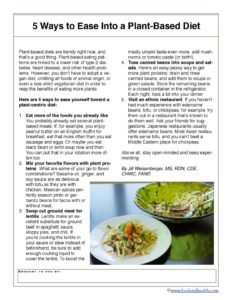5 Ways to Ease Into a Plant-Based Eating Pattern
Plant-based diets are trendy right now, and that’s a good thing. Plant-based eating patterns are linked to a lower risk of type 2 diabetes, heart disease, and other health problems. However, you don’t have to adopt a vegan diet, omitting all foods of animal origin, or even a less strict vegetarian diet in order to reap the benefits of eating more plants.Here are 5 ways to ease yourself toward a plant-centric diet:
- Eat more of the foods you already like. You probably already eat several plant-based meals. If, for example, you enjoy peanut butter on an English muffin for breakfast, eat that more often than you eat sausage and eggs. Or maybe you eat black bean or lentil soup now and then. You can put that in your rotation more often too.
- Mix your favorite flavors with plant proteins. What are some of your go-to flavor combinations? Sesame oil, ginger, and soy sauce are as delicious with tofu as they are with chicken. Mexican spices perfectly season pinto or garbanzo beans for tacos with or without meat.
- Swap out ground meat for lentils. Lentils make an excellent substitute for ground beef in spaghetti sauce, sloppy joes, and chili. If you’re cooking the lentils in your sauce or stew instead of beforehand, be sure to add enough cooking liquid to cover the lentils. To boost the meaty umami taste even more, add mushrooms or tomato paste (or both!).
- Toss canned beans into soups and salads. Here’s an easy-peasy way to get more plant proteins: drain and rinse canned beans, and add them to soups or green salads. Store the remaining beans in a closed container in the refrigerator. Each night, toss a bit into your dinner.
- Visit an ethnic restaurant. If you haven’t had much experience with edamame beans, tofu, or chickpeas, for example, try them out in a restaurant that’s known to do them well. Ask your friends for suggestions. Japanese restaurants usually offer edamame beans. Most Asian restaurants serve tofu, and you can’t beat a Middle Eastern place for chickpeas.
Above all, stay open-minded and keep experimenting.By Jill Weisenberger, MS, RDN, CDE, CHWC, FANDPrintable Handout:
